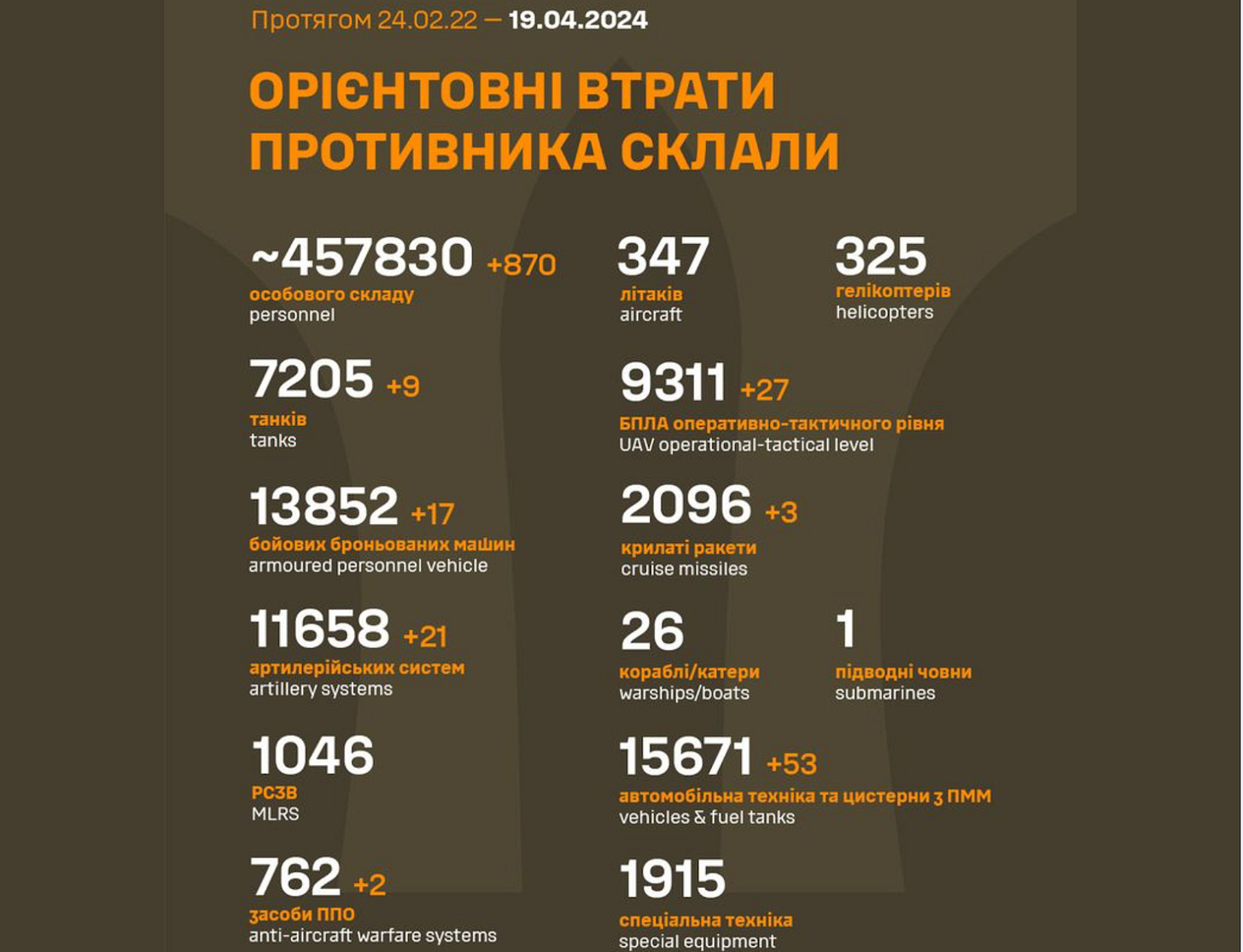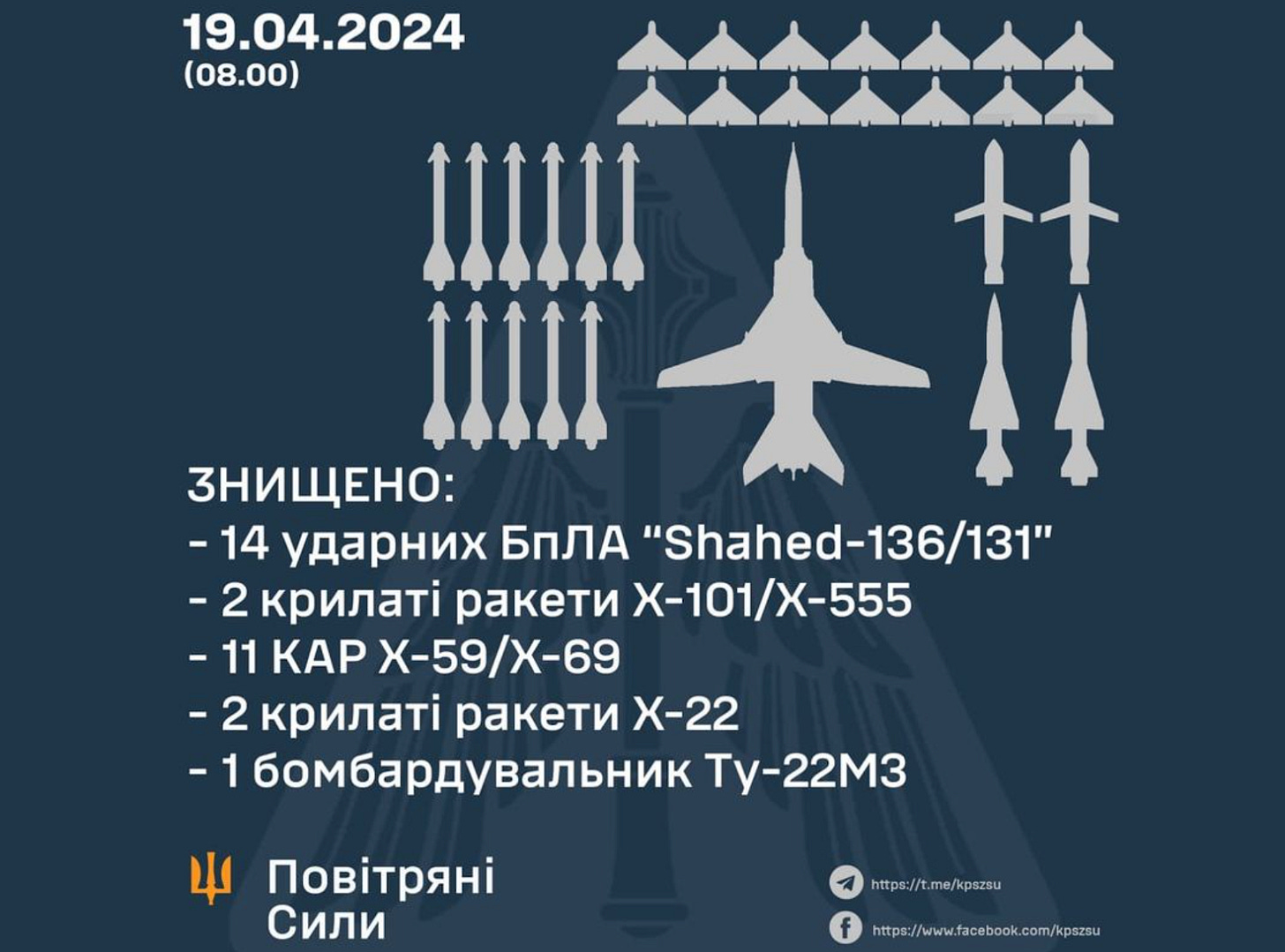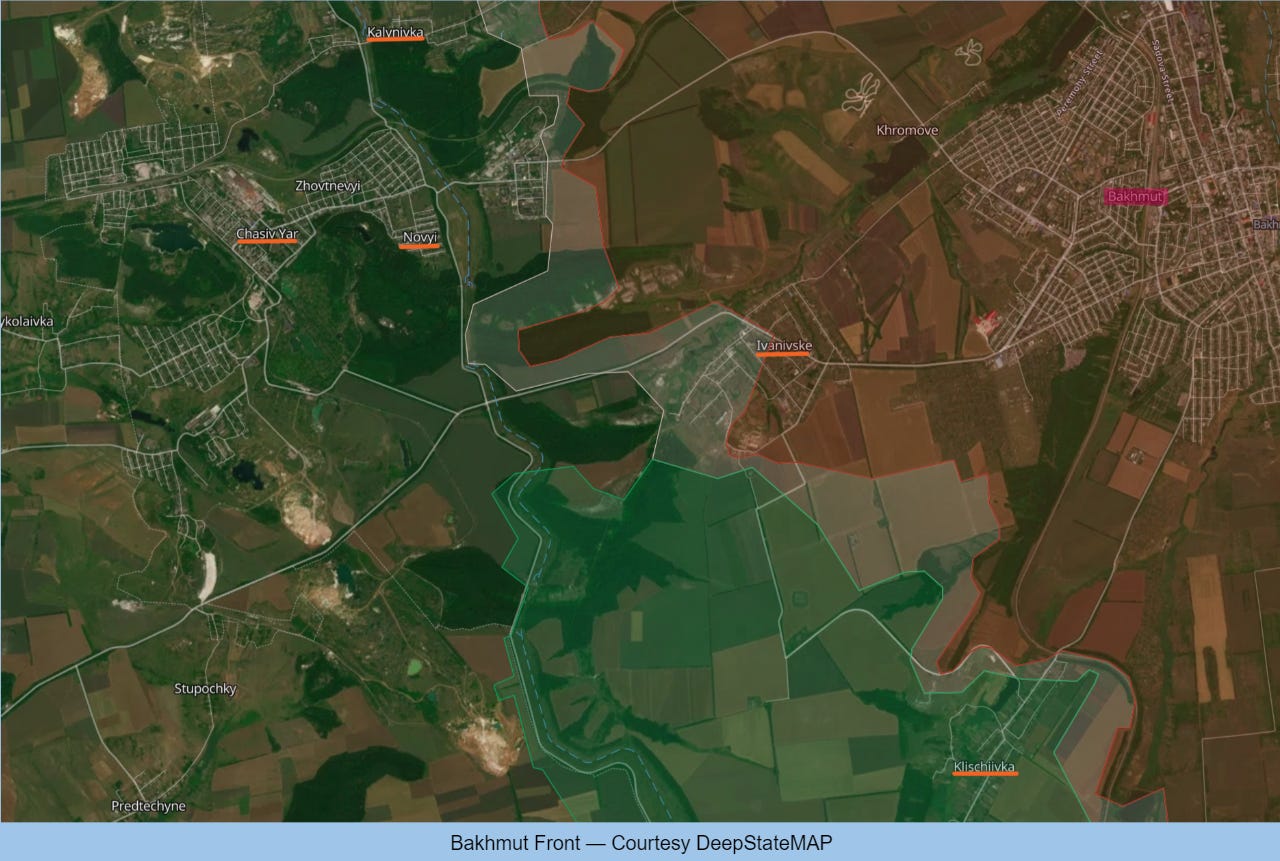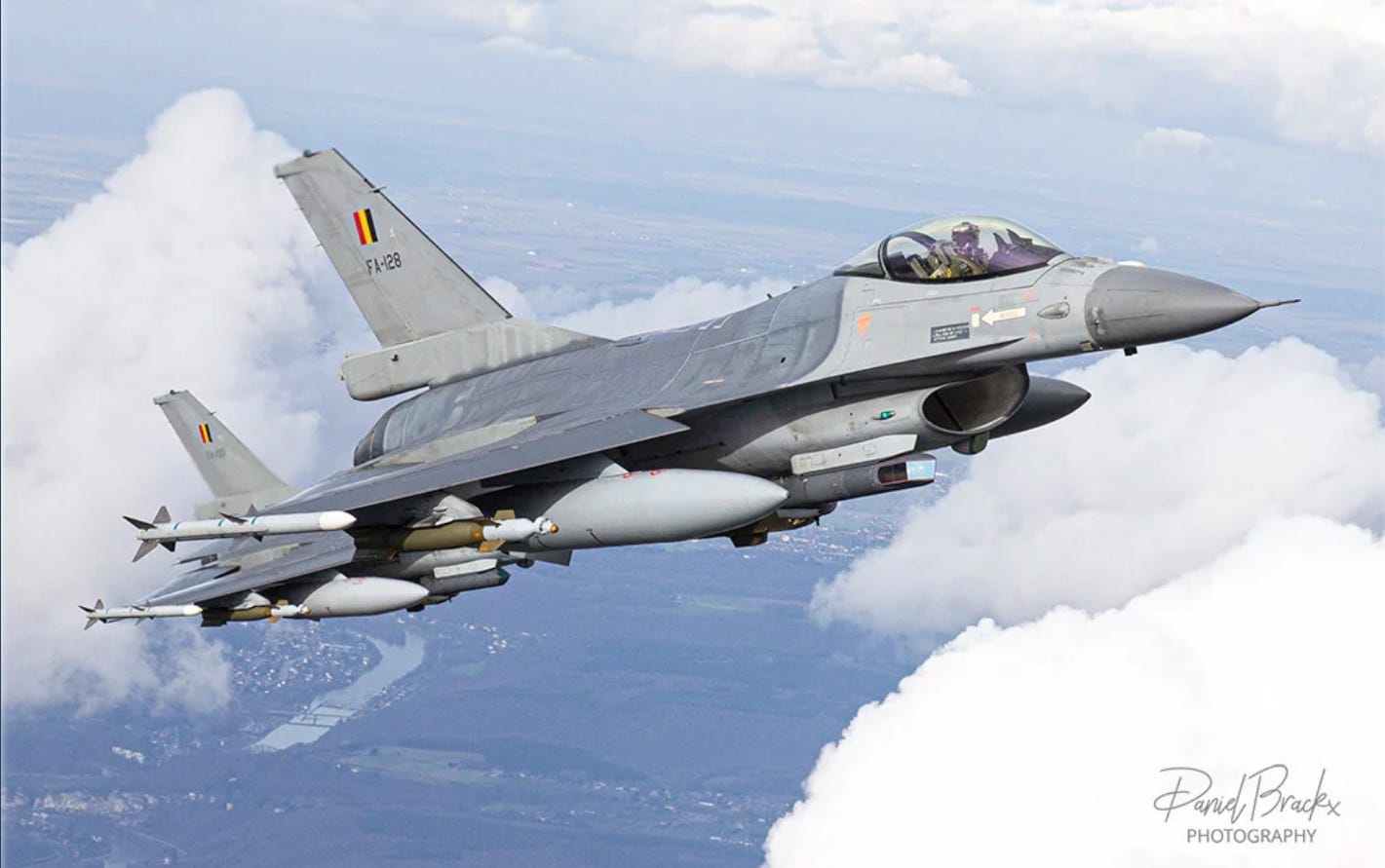Slava Ukraini! In early 2022 I began a Telegram channel aggregating news from a number of sources daily on the war in Ukraine. Since June 2023 I have provided a daily draft for the Ukraine War Brief Podcast collecting news from over 60 sources daily, much of which forms the basis of the script. While the Podcast is on hiatus I will make this Draft available here both on my own Substack and The People’s Media for those who wish to keep up with events on a daily basis.
INSIDE UKRAINE
ALONG THE CONTACT LINE
GSAFU Morning Report
The General Staff of the Armed Forces of Ukraine in its situation update at 06:00 on Apr. 19 stated that it was day 786 of the full-scale invasion of the Russian Federation against Ukraine.
During the past day, 86 combat engagements took place. Over the past 24 hours, the enemy carried out 11 missile strikes, 78 air strikes, and 82 MLRS attacks across the positions of our troops and settlements. As a result of the Russian attacks, unfortunately, there are dead and wounded among the civilian population. Destruction and damage to residential buildings and other civilian infrastructure.
At the same time, Ukrainian soldiers continue to inflict losses in manpower and equipment on the occupying troops, exhausting the enemy along the entire front line.
Ukrainian missile forces struck 1 command post, 2 artillery systems, 1 electronic warfare station, 1 concentration of troops and 1 ammunition depot
Air Force Daily Report
The Ukrainian Air Force in its situation update at 06:00 stated that during the previous day they launched air strikes on 9 concentrations of enemy troops
On the night of April 19, 2024, Russian occupiers made a combined attack by missiles of different types and UAVs.
In total, the enemy used 36 means of air assault - 22 missiles and 14 attack drones:
- 2 X-101 / X-555 cruise missiles launched from Tu-95 MS strategic bombers (area launches ryazan (Russia);
- 14 Shahed-131/13" (from the areas of Primorsk-Akhtarsk, Kursk region. (RF);
- 12 H-59 / H-69 cruise missiles (Kursk region. and from the aquatorí̈ of the azov sea);
- 2 Iskander-K ballistic missiles (from tot Ukrainian Crimea);
- 6 X-22 cruise missiles launched from Tu-22m3 strategic bombers (from the Black and Azov seas).
The air strike of the enemy involved Zenit missile troops of the Air Force, mobile fire groups and radio-electronic combat units of the Defense Forces of Ukraine.
As a result of anti-aircraft combat, 29 air targets were destroyed:
- 2 X-101 / X-555 missiles
- 14 Shahed-131/136"
- 11 h-59 / h-69; missiles
- 2 X-22 missiles
For the first time, the Zenitní missile units of the Air Force in interaction with the Main Intelligence Directorate (HUR) of the MoD of Ukraine destroyed a strategic bomber Tu-22M3 - a carrier of the X-22 missiles with which Russian terrorists hit peaceful Ukrainian cities. During today's attack, for the first time, two such missiles were destroyed.
Ukraine needs more means, more missiles to better protect from Russian terrorism the frontline territories.
Ukraine intercepts Russian bomber, Kh-22 cruise missiles in historic first
Reportedly, a modified Soviet-era S-200 air defence system was used to shoot down the Tu-22M3 strategic bomber. Two Kh-22 quasi-ballistic missiles were intercepted with unknown weapons. Euromaidan reports.
A Tu-22M3 Strategic Bomber, the type of aircraft Russia uses to strike Ukraine with air launched cruise missiles, crashed in the Russian Stavropol region after a missile attack on Ukraine’s Dnipro region on the morning of 19 April 2024.
The Russian Ministry of Defense claims the plane crashed due to a “technical malfunction.” A video shows the burning Tu-22M3 crashing over Russian Stavropol Krai, nearly 400 km from the frontline.
Ukraine’s air force claimed they shot down the aircraft. The commander of the Air Force also claimed that Ukraine managed to shoot down Kh-22 missiles for the first time. He didn’t specify what allowed Ukraine to shoot them down. Previously, Ukraine couldn’t down them because of the high speed and quasi-ballistic trajectory of Kh-22.
“For the first time, the anti-aircraft missile units of the Air Force, in cooperation with the Main Directorate of Intelligence of Ukraine, destroyed the Tu-22M3 long-range strategic bomber – the carrier of Kh-22 cruise missiles, which Russian terrorists use to attack peaceful Ukrainian cities,” said Ukraine’s Air Force Commander General Mykola Oleschuk.
The recent incident of Ukraine shooting down a Tu-22 strategic bomber became the first such case. Previously, Ukraine attacked several Russian bases with strategic bombers. Ukraine’s 24 TV channels reported, referring to its sources in intelligence, that a modified S-200 air defence system was used to shoot down the aircraft.
The Khortytsia operational-strategic group
(Responsible for the Kup’yans’k, Lyman, and Bakhmut axes, in the northeastern part of Ukraine. )
Kup’yans’k axis: The enemy did not conduct any offensive (assault) operations in this area. Ukrainian Defense Forces continue to hold their positions.
Lyman axis: Ukrainian defenders repelled attacks near Tors’ke and Yampolivka (Donetsk oblast) where the occupiers attempted to breach Ukrainian defensive lines.
Bakhmut axis: Ukrainian forces repelled 25 Russian attacks, supported by aviation, in the vicinities of Bilohorivka (Luhansk oblast) Verkhn’okam’yans’ke, Vyimka,Kalynivka, Chasiv Yar, Novyi, Ivanivske and Klishchiivka (Donetsk oblast).
The Tavria operational-strategic group
(Responsible for the Avdiivka, Novopavlivka, and Orikhiv axes, in the central-eastern and southeastern part of Ukraine.)
Avdiivka axis: Ukrainian defenders repelled 16 attacks in the vicinities of Ocheretyne, Novokalynove, Berdychi, Pervomais’ke and Nevel’s’ke (Donetsk oblast).where the invaders, with air support, attempted to dislodge Ukrainian troops from their positions.
Novopavlivka axis: Ukrainian Defence Forces continue to hold back the enemy in the vicinities of Heorhiivka, Pobjeda, Novomykhailivka and Urozhaine (Donetsk oblast), where the invaders, with air support, made 23x attempts to breach Ukrainian defence.
Orikhiv axis: The enemy conducted 4 attacks on positions of Ukrainian defenders in the vicinities of Staromaiors’ke (Donetsk oblast), Robotyne (Zaporizhzhia oblast).
The Odesa operational-strategic group
(Responsible for Kherson, Qırım, (also known as Crimea) and the Black Sea.)
Kherson axis: Ukrainian defenders continue to maintain their positions. Over the past day, the enemy carried out 3 unsuccessful assaults on the positions of the Ukrainian Defence Forces on the left bank of the Dnipro River.
TEMPORARILY OCCUPIED TERRITORIES
Drone strike hits Zaporizhzhia nuclear power plant for a third time, IAEA denied in site access
The International Atomic Energy Agency (IAEA) reported a third drone attack on the training centre at the Zaporizhzhia nuclear power plant site within the last two weeks. The IAEA team was denied access to assess the incident at the training centre the organisation reported.
“The IAEA team was denied access to assess the incident at the training centre outside the perimeter of the Zaporizhzhia NPP site, as the station cited potential safety risks,” the organisation reported.
This is the third attack on the training centre in the last two weeks. On 7 April, the United Nations’ International Atomic Energy Agency reported that drone attacks had damaged the structures of one of the plant’s six reactors. The Russian side claims that Ukrainian drones attacked the Zaporizhzhia NPP. Ukraine’s Main Intelligence Directorate of the Ministry of Defense denies Kyiv’s involvement in the attack on the plant. The UN Council also said Russia is responsible for the attack.
According to IAEA Director General Rafael Grossi, the third attack occurred on Apr.18 but did not result in any damage or casualties.
Greenpeace Germany commissioned analysis of ZNPP drone attacks conclude Russia most likely the perpetrator
British military analysts, commissioned by the international organisation Greenpeace Germany, reported that the Russian government’s claims of alleged Ukrainian drone attacks on the Zaporizhzhia Nuclear Power Plant show signs of being staged by Russia. The report said that the UAVs were likely launched near the Zaporizhzhia NPP and, therefore, with a 55-75% probability, could have come from Russian-occupied territory.
Pertinent excerpts from the report are posted below:
This suggests that the UAV operator would need to be relatively close to the plant, the closest point of Ukrainian held territory is approximately 10km. Such short range devices are likely to have been launched close to the ZNPP and likely, but not conclusively, from within Russian held territory.
—
However when we consider the intent aspect of the equation, it is difficult to identify how Ukraine would benefit from attacking the infrastructure at ZNPP. There is no discernible strategic, operational or tactical benefit to the Ukrainians by attacking the power plant, in fact it is in Ukraine’s best interest to ensure the plant remains secure. Also, looking longer term and in the instance of a Russian defeat, Ukraine would need its critical national infrastructure intact to rebuild the country. As such it is considered unlikely that Ukraine carried out the attacks against ZNPP.
—
However, the Russians are experts in what is termed as maskirovka or deception. It would benefit them to demonstrate Ukrainian irresponsibility with regards to nuclear safety and put pressure on the international community to sanction Ukraine for such behaviour. This would benefit Russia. It is of note that the UAV attacks against the plant are not against troops or military equipment, such as they were when Ukraine admitted conducting a UAV based attack in July 2022. In this instance, the attacks were against the infrastructure of the plant which would be of no tactical benefit to Ukraine and employing payloads that would be highly unlikely to cause any significant damage to the plant.
—
After considering this analysis, while it cannot be confirmed, it is a realistic possibility that this could be a false flag operation designed to discredit the Ukrainians with regards to nuclear safety and to alleviate direct pressure on the Russians from the international community.
THE HOME FRONT
Russian morning missile strike hits residential building in Dnipro, killing civilians and children
Missiles also hit the cities of Synelnykove, Pavlohrad, and Kryvyi Rih in Dnipropetrovsk oblast, killing and wounding people there. Air defence shot down nine missiles over the Dnipro Oblast. Euormaidan reports.
A Russian morning attack killed at least two civilians and injured 15 in the city of Dnipro following a Russian missile strike, according to Serhiy Lysak, head of the Dnipropetrovsk Oblast Military Administration. An 8-year-old child later died in the hospital. Additionally, a woman was killed in Synelnykove, the city in the Dnipropetrovsk Oblast. The number of casualties is expected to rise as rescue operations are still ongoing.
The missile hit a residential building close to the city centre. The five-story building in Dnipro was partially destroyed and on fire, potentially trapping people under the rubble. Two “infrastructure facilities” were damaged too. In Synelnykove, four private houses were partially destroyed, and eight more were damaged.
In Pavlohrad, an enterprise was damaged, while the cities of Nikopol and Marhanets were shelled with artillery in the evening, resulting in damage to two private houses.
RUSSIAN WORLD
Ukraine is ignoring US warnings to end drone operations inside Russia
Since President Volodymyr Zelensky prioritised drone technology, Ukraine has invested hundreds of millions of dollars into long-range drones, capable of searching out and striking distant targets. Half a dozen firms now make them.
The best of Ukraine’s new drones have a range of 3,000km, able to reach all the Siberia. Born out of necessity—the West has been reluctant to provide Ukraine with long-range weapons—the programme has disrupted much of Russia’s oil and military infrastructure. But the White House is not happy. It is pushing the Ukrainians to stop the strikes. The Economist reports.
America’s concerns have varied, from a rise in the oil price to the prospect of an uncontrollable tit-for-tat in which Ukraine could end up the loser. Fears of the latter rose in late March, when Russia inflicted millions of dollars of damage on Ukraine’s energy infrastructure. The attacks revealed gaps in air defences and vulnerabilities to Russia’s new Kh-69 low-altitude cruise missile. On April 11th such missiles destroyed Ukraine’s Trypilska power station, 40km from Kyiv, though it was in range of the capital’s Patriot air-defence systems.
So far, Ukraine is ignoring American advice to call off the strikes. “Detective”, an intelligence officer responsible for part of the programme, says he has not received instructions to dial down operations. Yes, there has been a switch away from aiming at oil infrastructure in the past week, but it is probably temporary. “Our targets change day to day. We keep the Russians on their toes.”
One long-range-drone producer claims that not every American representative agrees with its policy. His contacts “winked” while they delivered warnings. “They’re privately telling us to keep going.” The producer predicted an expansion of Ukraine’s drone programme in the months to come. “Russia is scorching Ukrainian earth. It’s time we did the same to European Russia.”
Grumpy Here — It does not take a rocket scientist to figure out the true reason for the White House’s concern with Ukraine attacking Russian oil infrastructure is that they are under enormous pressure from International oil corporations that are heavily invested in not only Russia oil and gas but in other areas of the region that depend on Russia’s good graces (like Kazakstan) in order to get product to market.
The real story here is the total inability, due to a combination of incompetence, corruption and geography, to protect strategic assets like air bases, oil and weapons production facilities anywhere in the Russian Federation.
NEWS WORLDWIDE
Two Arrested In Germany For Planning Sabotage In Favor Of Russia
Two men with dual German-Russian citizenship have been arrested in Germany for allegedly plotting acts of sabotage aimed at undermining military support for Ukraine, the German prosecutor's office reported on Apr. 18.
“These actions were intended, in particular, to undermine the military support that Germany provides to Ukraine against the Russian aggressive war” the prosecutor's office stated.
Law enforcement officers searched the homes and workplaces of suspects accused of working for foreign intelligence.
One suspect, identified as Dieter S., had been discussing possible actions with a person connected to Russian intelligence since October 2023, the prosecutor's office said in a statement. Dieter S. was ready to carry out attacks on military facilities, including U.S. ones, in Germany. German media reported the Grafenwehr military base in Bavaria, where Ukrainian soldiers are trained to use U.S. Abrams tanks, was among the likely target.
CIA Director warns Ukraine could lose the war this year without US Military Aid
CIA Director William Burns delivered a stark warning to US lawmakers on Apr. 18, stating that Ukraine could lose the war against Russia by the end of 2024 if Congress fails to approve crucial military assistance that has been stalled for months, according to Politico.
Speaking at an event at the George W. Bush Presidential Center, Burns urged lawmakers to pass the supplemental that would dedicate billions to Ukraine’s war efforts.
“With the boost that would come from military assistance, both practically and psychologically, Ukrainians are entirely capable of holding their own through 2024 and puncturing Putin’s arrogant view that time is on his side,” he said.
It’s perhaps the strongest warning from a senior administration official yet regarding the war, coming as officials in Kyiv warn that a looming Russian offensive in the summer — which would see massive waves of troops invading Ukraine — could overwhelm Kyiv’s struggling soldiers.
Burns’ remarks come a day after House Speaker Mike Johnson unveiled his highly-anticipated foreign aid package, which hangs in the balance as the speaker tries to secure the votes needed to tee up floor debate.
Supporting Ukraine right now is about more than the war with Russia, Burns argued during the event.
“It’s also about Xi Jinping in China, his ambitions, and our allies and partners in the Indo-Pacific,” he said. “This is really a question of whether or not our adversaries understand our reliability and determination and whether our allies and partners understand that as well.”
Polish citizen detained for offering to help Russian secret services assassinate Zelenskyy
Ukrainian law enforcement officers, jointly with their Polish counterparts, have detained a Polish citizen on suspicion of being willing to act in favour of Russia’s secret services. The detainee proposed an assassination attempt on Ukrainian President Volodymyr Zelenskyy. The Polish Ministry of Justice reports.
The investigation revealed that the suspect, on his own initiative, established contact with representatives of Russia's Armed Forces Command and informed them of his willingness to work for Russia's military intelligence.
The detainee’s tasks included collecting and transmitting intelligence on the security of Rzeszów-Jasionka Airport in Poland to Russia. This was intended, among other things, to assist the Russian secret services in planning a possible assassination attempt on Ukrainian President Volodymyr Zelenskyy during his stay in Poland.
Ukrainian prosecutors and SSU officers informed their Polish counterparts of the possible criminal offence and handed over key evidence in the case as part of international legal assistance.
It is reported that, due to successful measures and prompt exchange of information between the two countries, the asset of Russia's secret services had been identified and detained in Poland.
The Polish prosecutor's office charged the detainee with willingness to act in favour of a foreign intelligence service.
MILITARY & TECH
Belgian PM says first F-16s to be delivered to Ukraine by early summer
During a briefing in Brussels by Belgian Prime Minister Alexander de Croo announced that the first F-16 multi-role fighter jets with trained pilots are to be delivered to Ukraine by early summer.
According to Belgian Prime Minister Alexander de Croo, Belgium should be able to deliver the promised F-16s ”before the summer.” He emphasised that this would include the Ukrainian pilots, having been trained to such an degree that they are ready to operate the Belgian aircraft.
Besides the F-16s, De Croo also spoke on the fact that Belgium often cannot publicly announce what exactly the country delivers to Ukraine, as to not give Russia an exact idea of what is being delivered.
He did note, however, that an unspecified amount of artillery shells are being delivered to Ukraine as of this moment. This is the result of his visit to Kyiv in February of this year, where the Belgian PM announced that his country would take 200 million Euros from frozen Russian assets to fund artillery shells for Ukraine.
That’s it for today’s Draft folks if you would like to keep up with events in Ukraine daily please consider subscribing, its free!
Feel free to share this update with your friends. Heroyam Slava!



























